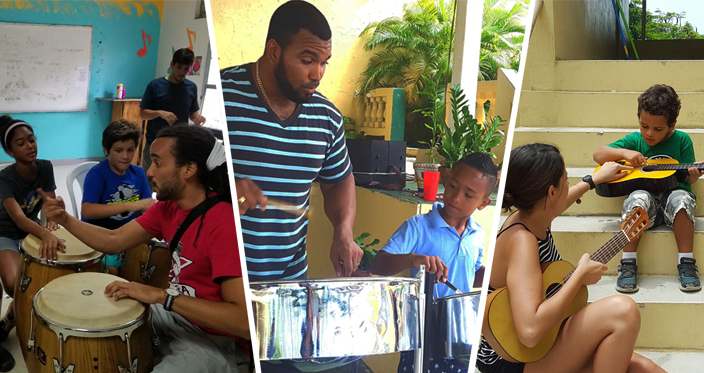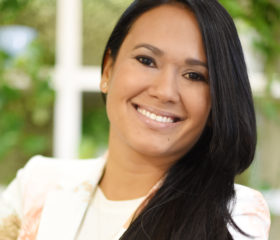
Flamboyan is working closely with twelve arts organizations on the island to preserve, amplify, and sustain the arts in Puerto Rico with an additional round of grantees to be announced this summer. This series will spotlight all twelve Arts Fund grantee organizations.
Culebra, a municipality (county) of just over 11 miles and just under two thousand residents, is one of Puerto Rico’s top attractions. It is actually a tiny island 17 miles off the northeast coast of the main island. The people who call Culebra home are called Culebrenses–and the island boasts Flamenco Beach, considered one of the world’s most beautiful.
Residents of Culebra often need to travel over an hour to reach Puerto Rico’s main island, using unreliable public maritime transportation services. There are only two schools in Culebra: one public and one private. Once students are ready for college, they need to move to the main island to pursue an education or a professional career.
Culebra’s lifestyle is unpretentious, and one of the main concerns of its people is being self-sustaining and provide essentials for their own. That includes preserving nature and teaching their history, building pride, and providing educational and artistic alternatives for their children. That’s where the Culebra Foundation comes in, along with their Música Pa’ Culebra program, which is being funded by the Flamboyan Arts Fund.
We asked them to answer five questions about their work. Read on to learn more about this organization.
What’s the story behind the creation of Música Pa’ Culebra? What motivated you to found it?
The Culebra Foundation – incorporated in 1994 – is dedicated to preserving the environment, culture, history, and community of the beautiful island of Culebra. Its founder, Juan J. Romero Sanes, is a culebrense who has devoted his life to this mission. Through educational activities that involve the people, our goal is to protect the island’s natural resources. We understand that through the study and teaching of issues related to nature, promoting values and sustainability, we can develop a culture of activism in the community for our own prosperity.
What are your main achievements?
This year marks the 25th anniversary of our work for the community. In this period, the Culebra Foundation managed the transfer of the Culebrita Lighthouse to the Municipality of Culebra and now supports the efforts of the nonprofit Para La Naturaleza for its restoration.
Also, we restored two historic buildings. One is the only museum we have in Culebra, and it has been open for more than ten years to residents and visitors. We also made several oral history documentaries, and we have the most comprehensive collection of documents and photographs of Culebra. We have also published books and calendars as part of our projects.
Five years ago, we organized the art project Culebra es Ley (Culebra is Law) with the collaboration of Alexis Busquets, an artist and producer based in Puerto Rico. During this project, 17 art interventions were carried out in the community. It was an exceptional experience because, for the first time, we could create an experience where artists interacted with the members of the community. In 2017, Hurricane Maria destroyed the sculpture Hector The Protector of international artist Thomas Dambo, and our organization was the promoter of getting the artist back to Culebra to create a new version with the participation of our people.
Four years ago, we started the program Música Pa’ Culebra (Music for Culebra). It offers free music classes in piano, singing, guitar, percussion, sound and studio recording. Students from both schools in Culebra participate, and we have formed two bands. We have continued expanding the cultural part of our work, and now we have “rescued” a building in the town. In this space, we have gradually built a school of Fine Arts, where besides music, art, and dramatic arts, we will soon incorporate dance and other artistic projects related to protecting Culebra’s landscape.
What was the reality of your organization before receiving the Flamboyan Arts Fund grant?
The music program was at a critical moment. We were starting to see the results of more than three years of hard work and efforts in the communities of Culebra.
How are you using the funds you received?
Our most significant expenditure is payment for teachers’ labor. The funds will be used to cover this expense and ensure the continuity of our work.
What do you think about this collaboration between Flamboyan Foundation, Lin-Manuel Miranda, his family and the producers of Hamilton to create this Fund to support arts and culture in Puerto Rico?
It is a real honor to be recognized. We feel that they see the potential in our work, and it increases our motivation to continue and aspire to do more. Due to our geographical location, it is practically impossible for children in Culebra to participate in activities related to art. This program seeks not only to meet this need, but also to develop all the skills that are attached to music like teamwork, perseverance, and others.
What Lin-Manuel Miranda, his family, Hamilton producer Jeffrey Seller and Flamboyan Foundation have done for Puerto Rico has been magical. It has brought joy and massive attention to the talent, beauty, and importance of the arts in the process of restoration after Hurricane Maria. Knowing there is support for the arts is vital, not only for our culture but also for our sense of worth in Puerto Rico.
Look out next week for another opportunity to meet a Flamboyan Arts Fund inaugural grantee! Learn more about the Arts Fund @ http://www.flamboyanartsfund.org.

Rosiris Ramos Meléndez is the Communications Manager in our Puerto Rico office. Learn more about her at https://flamboyanfoundation.org/team_members/rosiris-a-ramos-melendez/.